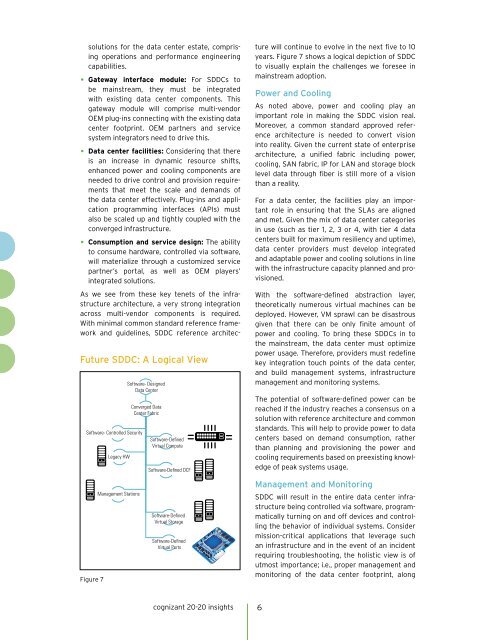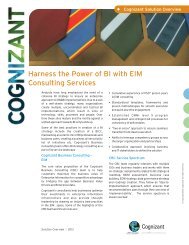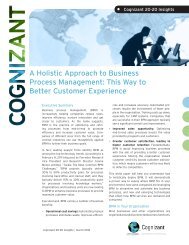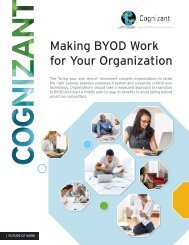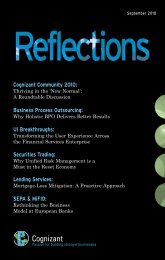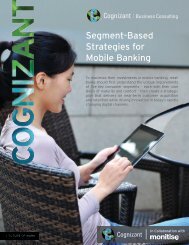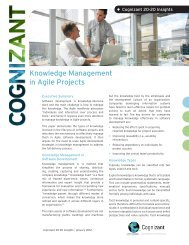The Journey Toward the Software-Defined Data Center - Cognizant
The Journey Toward the Software-Defined Data Center - Cognizant
The Journey Toward the Software-Defined Data Center - Cognizant
You also want an ePaper? Increase the reach of your titles
YUMPU automatically turns print PDFs into web optimized ePapers that Google loves.
solutions for <strong>the</strong> data center estate, comprisingoperations and performance engineeringcapabilities.• Gateway interface module: For SDDCs tobe mainstream, <strong>the</strong>y must be integratedwith existing data center components. Thisgateway module will comprise multi-vendorOEM plug-ins connecting with <strong>the</strong> existing datacenter footprint. OEM partners and servicesystem integrators need to drive this.• <strong>Data</strong> center facilities: Considering that <strong>the</strong>reis an increase in dynamic resource shifts,enhanced power and cooling components areneeded to drive control and provision requirementsthat meet <strong>the</strong> scale and demands of<strong>the</strong> data center effectively. Plug-ins and applicationprogramming interfaces (APIs) mustalso be scaled up and tightly coupled with <strong>the</strong>converged infrastructure.• Consumption and service design: <strong>The</strong> abilityto consume hardware, controlled via software,will materialize through a customized servicepartner’s portal, as well as OEM players’integrated solutions.Future SDDC: A Logical View<strong>Software</strong>- Controlled SecurityFigure 7Legacy HWManagement Stations<strong>Software</strong>- Designed<strong>Data</strong> <strong>Center</strong>Converged <strong>Data</strong><strong>Center</strong> Fabric<strong>Software</strong>-<strong>Defined</strong>Virtual Compute<strong>Software</strong>-<strong>Defined</strong> DCF<strong>Software</strong>-<strong>Defined</strong>Virtual Storage<strong>Software</strong>-<strong>Defined</strong>Virtual PortsAs we see from <strong>the</strong>se key tenets of <strong>the</strong> infrastructurearchitecture, a very strong integrationacross multi-vendor components is required.With minimal common standard reference frameworkand guidelines, SDDC reference architecturewill continue to evolve in <strong>the</strong> next five to 10years. Figure 7 shows a logical depiction of SDDCto visually explain <strong>the</strong> challenges we foresee inmainstream adoption.Power and CoolingAs noted above, power and cooling play animportant role in making <strong>the</strong> SDDC vision real.Moreover, a common standard approved referencearchitecture is needed to convert visioninto reality. Given <strong>the</strong> current state of enterprisearchitecture, a unified fabric including power,cooling, SAN fabric, IP for LAN and storage blocklevel data through fiber is still more of a visionthan a reality.For a data center, <strong>the</strong> facilities play an importantrole in ensuring that <strong>the</strong> SLAs are alignedand met. Given <strong>the</strong> mix of data center categoriesin use (such as tier 1, 2, 3 or 4, with tier 4 datacenters built for maximum resiliency and uptime),data center providers must develop integratedand adaptable power and cooling solutions in linewith <strong>the</strong> infrastructure capacity planned and provisioned.With <strong>the</strong> software-defined abstraction layer,<strong>the</strong>oretically numerous virtual machines can bedeployed. However, VM sprawl can be disastrousgiven that <strong>the</strong>re can be only finite amount ofpower and cooling. To bring <strong>the</strong>se SDDCs in to<strong>the</strong> mainstream, <strong>the</strong> data center must optimizepower usage. <strong>The</strong>refore, providers must redefinekey integration touch points of <strong>the</strong> data center,and build management systems, infrastructuremanagement and monitoring systems.<strong>The</strong> potential of software-defined power can bereached if <strong>the</strong> industry reaches a consensus on asolution with reference architecture and commonstandards. This will help to provide power to datacenters based on demand consumption, ra<strong>the</strong>rthan planning and provisioning <strong>the</strong> power andcooling requirements based on preexisting knowledgeof peak systems usage.Management and MonitoringSDDC will result in <strong>the</strong> entire data center infrastructurebeing controlled via software, programmaticallyturning on and off devices and controlling<strong>the</strong> behavior of individual systems. Considermission-critical applications that leverage suchan infrastructure and in <strong>the</strong> event of an incidentrequiring troubleshooting, <strong>the</strong> holistic view is ofutmost importance; i.e., proper management andmonitoring of <strong>the</strong> data center footprint, alongcognizant 20-20 insights 6


